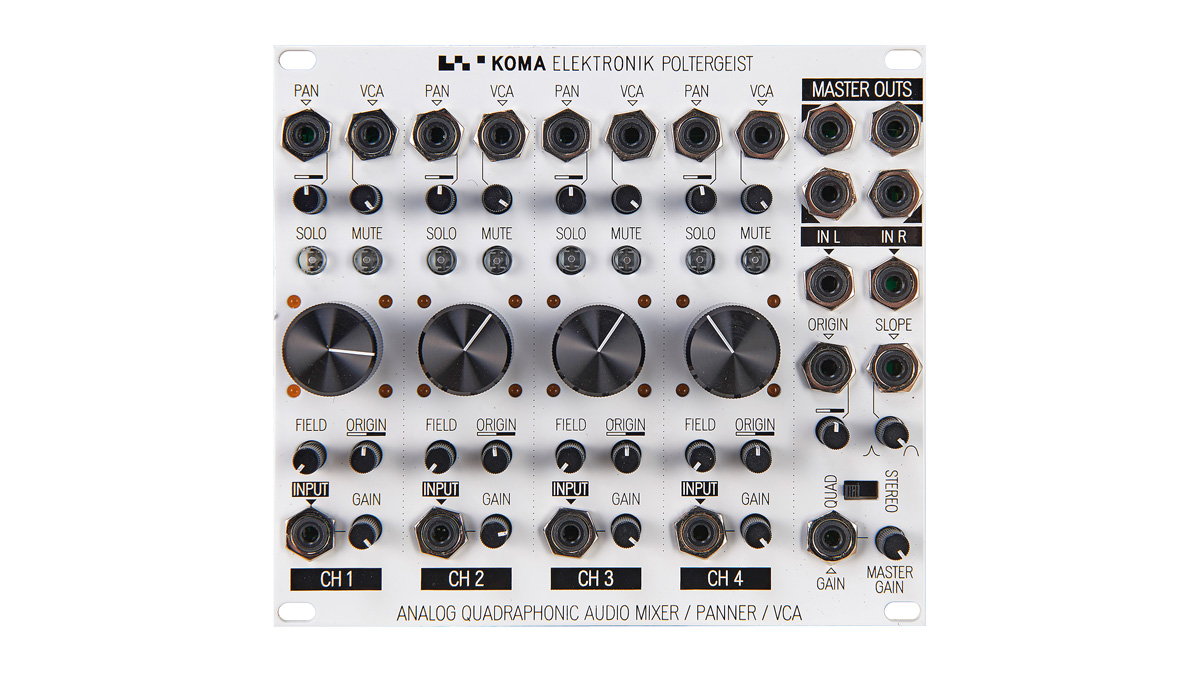MusicRadar Verdict
Koma is pricey but fulfils a need and gives a lot of scope for deep experimentation when combined with a few LFOs or other modulation sources.
Pros
- +
Numerous inputs, outputs and patching options makes for a wide range of configuration possibilities, particularly when it comes to modulation.
Cons
- -
The hefty price may make other simpler options more attractive. No joystick.
MusicRadar's got your back
Koma is returning to Eurorack with the Poltergeist, a knob and socket laden 28HP unit featuring the familiar black and white Koma livery.
Centre stage is taken by four large metal pots - each surrounded by four LEDs, a clue to the surround-capabilities of the unit. The fact that it is labelled an 'Analog Quadraphonic Audio Mixer/Panner/ VCA' indicates that Koma intends this as more than a single-purpose device.
Poltergeist can be switched to work as a simpler stereo-only processing device, but we'll be exploring it from a quadraphonic perspective.
Clearly the first requirement is a suitable monitoring environment, and anyone set up for 5.1 can adapt their system, though it will likely mean moving speakers. Unless you intend on encoding the resultant 4-channel audio into a binaural headphone mix, a more likely scenario is that the unit will be used for live electronic music performance - and it's in this area Poltergeist might find a solid niche.
Four master quadrant outputs are fed from four quad-mixable inputs and a more straightforward stereo aux input. Each individual input channel has a single jack input with gain control plus solo and mute buttons, while a VCA input provides external control over the channel level.
The most important aspect here though is the quad panner control. As this rotates, the four LEDs indicate routing to the four master outs in turn. Although the pot doesn't rotate through a complete 360°, when fully clockwise the routing returns to the start position.
There are clear disadvantages in using this pot-based system, as opposed to the vector joystick used by Intellijel's Planar module. However, the way in which the panning can be modulated in the Poltergeist allows for some quite different results compared to vector-style X-Y modulation.
Want all the hottest music and gear news, reviews, deals, features and more, direct to your inbox? Sign up here.
This thinking is exemplified by the Field control, that mixes an inverted version of the inputs with the output, allowing you to pan a 'hole' in the mix around the space in a similar manner to the sound applied to a chosen input. This audio cancellation, or 'subtractive mixing' can be both strange and useful.
The oddly-named Origin control determines the strength of any CV on pan modulation for that channel. The final piece of the pie is the Slope input, and associated control, for providing further panning animation options.
Getting the most from Poltergeist beyond its quad-audio functionality may take time and experimentation, but it is an interesting addition to Koma's roster.
